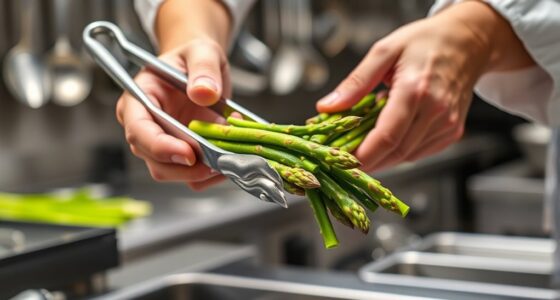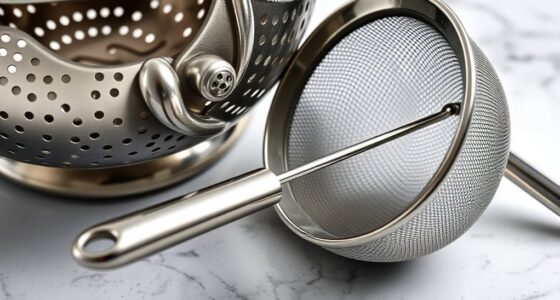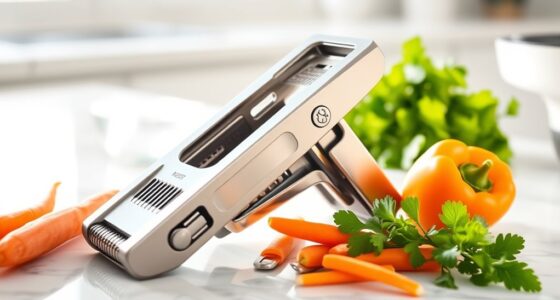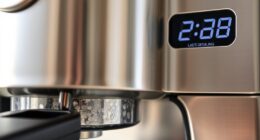To cut faster without risking cuts, guarantee your knife is sharp and well-maintained, as dull blades require more force and are more dangerous. Grip the handle firmly and curl your fingers inward to protect your fingertips, guiding the knife smoothly with controlled rocking motions. Keep your workspace stable and your cutting surface secure. Good body posture and steady movements help you work efficiently while reducing injury risk. Continue exploring these tips for safer, quicker chopping techniques.
Key Takeaways
- Keep knives sharp through regular honing and professional sharpening to ensure clean cuts and reduce slip risks.
- Use a proper grip and the claw technique to maintain control and protect fingertips during slicing.
- Ensure your workspace is stable and organized, with a non-slip surface to prevent accidents and improve efficiency.
- Maintain good body posture with feet shoulder-width apart and elbows close to minimize fatigue and enhance control.
- Store knives properly and handle them carefully to preserve sharpness and prevent damage that could lead to hazards.
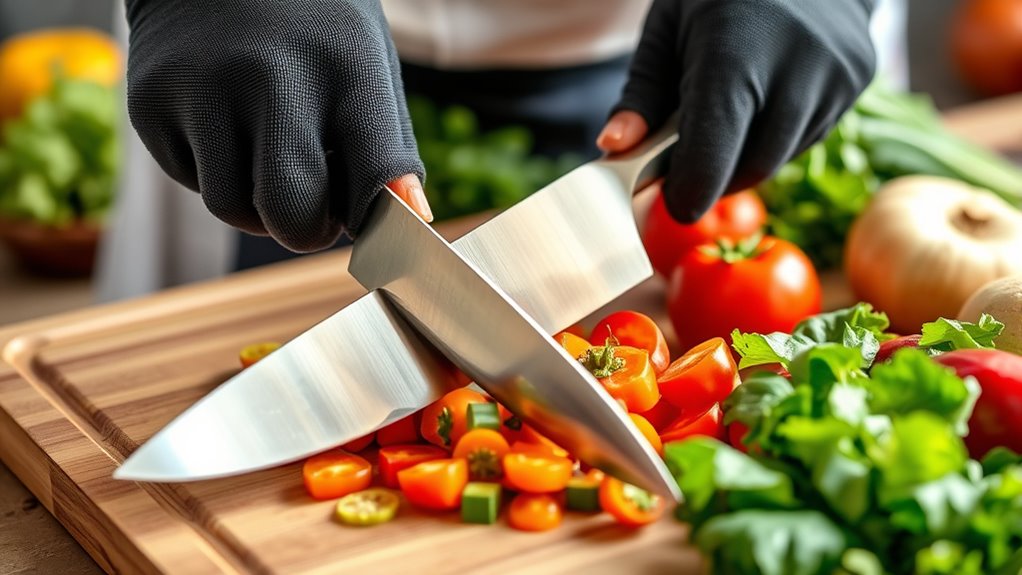
Have you ever wondered how to handle knives safely in the kitchen? Mastering proper knife techniques isn’t just about avoiding injuries—it also helps you cut faster and more efficiently. The key is to develop good habits from the start. Always use a sharp knife; dull blades require more force and are prone to slipping, increasing the risk of cuts. Regularly hone your knives to keep the edge aligned, and have them professionally sharpened when needed. A sharp knife not only cuts better but is safer because it’s less likely to slip during use.
Using sharp knives enhances safety and efficiency in the kitchen.
When you’re preparing to cut, grip the handle firmly but comfortably. Position your hand so that your fingers are curled inward, gripping the handle securely. Your other hand should hold the food with your fingertips tucked under, forming a claw shape. This “claw grip” keeps your fingertips safe and guides the knife smoothly through ingredients. As you cut, use a rocking motion—press down with the heel of the blade and lift the tip slightly, maintaining contact with the cutting board. This technique allows for controlled, swift cuts, reducing fatigue and increasing precision.
Keep the cutting surface stable and clean. A non-slip mat or damp towel underneath the board prevents slipping, giving you better control. Make sure your workspace is organized, with everything you need within easy reach. When chopping, use a steady, rhythmic motion rather than frantic hacking. This not only speeds up your work but minimizes the chance of slipping or losing control. As you become more comfortable, you’ll notice you can work faster without sacrificing safety.
Additionally, be mindful of your body position. Stand with your feet shoulder-width apart and keep your elbows close to your sides. This stance provides stability and reduces strain. Don’t rush through cuts; focus on consistency and control. Over time, your muscle memory will develop, allowing you to cut faster with fewer mistakes or accidents. Remember, safety and speed go hand in hand—cutting carefully now prevents injuries that could slow you down later.
Finally, always pay attention to your knife’s condition. Avoid using a damaged or chipped blade, as it can behave unpredictably. Store your knives properly—preferably in a knife block or on a magnetic strip—to keep blades protected and sharp. Proper handling, regular maintenance, and mindful technique are the pillars of safe, efficient cutting. With practice, you’ll find that you can increase your speed without compromising safety, making your time in the kitchen both productive and enjoyable.
Frequently Asked Questions
What Types of Knives Are Safest for Beginners?
As a beginner, you should start with a paring knife or a serrated bread knife. These knives are safer because they have smaller blades and are easier to control, reducing the risk of cuts. Look for knives with non-slip handles for added safety. Practice using these knives on soft ingredients first, and always cut away from your body to prevent accidents. With proper technique, you’ll cut confidently and safely.
How Often Should I Sharpen My Kitchen Knives?
You should sharpen your kitchen knives every 1 to 2 weeks, depending on how often you cook and the type of knives you use. Regular honing with a honing steel helps maintain the edge, but actual sharpening removes metal and restores the blade’s sharpness. If your knives start to catch or require more force to cut, it’s time to sharpen them. Proper maintenance keeps your cuts safe and efficient.
What Is the Best Cutting Technique to Avoid Injuries?
Think of your knife as a swift, confident dancer—graceful and precise. To avoid injuries, keep your fingers tucked under your knuckles, forming a claw grip. Use a smooth rocking motion, guiding the knife with control, not force. Focus on your cut’s rhythm, maintaining a steady pace. Always pay attention, and never rush. This mindful technique keeps your fingers safe and your cuts clean, like a seasoned chef.
Are There Specific Gloves to Enhance Safety While Cutting?
Yes, there are specific gloves designed to enhance safety while cutting. Look for cut-resistant gloves made from materials like Kevlar or Dyneema, which provide a strong barrier against accidental slips. These gloves give you better grip and protect your hands without sacrificing dexterity. Choose gloves that fit snugly and are comfortable to wear for extended periods. Always make sure they are appropriate for the type of cutting you do to maximize safety.
How Do I Properly Store Knives to Prevent Accidents?
You should store knives in a designated knife block, on a magnetic strip, or in a drawer with a knife guard. Always guarantee blades are dry and clean before storing to prevent rust and accidents. Keep knives out of reach of children, and never store loose in a drawer where you can accidentally cut yourself when reaching in. Proper storage keeps your knives safe and easily accessible when you need them.
Conclusion
Now that you know the secrets to safe and swift cutting, you’re like a skilled artist wielding a sharp brush. With every precise slice, you paint a picture of confidence and control in your kitchen. Remember, safety is your trusted compass guiding each move, turning potential chaos into a symphony of efficiency. So, sharpen your skills, stay alert, and let your knives dance gracefully, carving out culinary masterpieces without a hitch.


